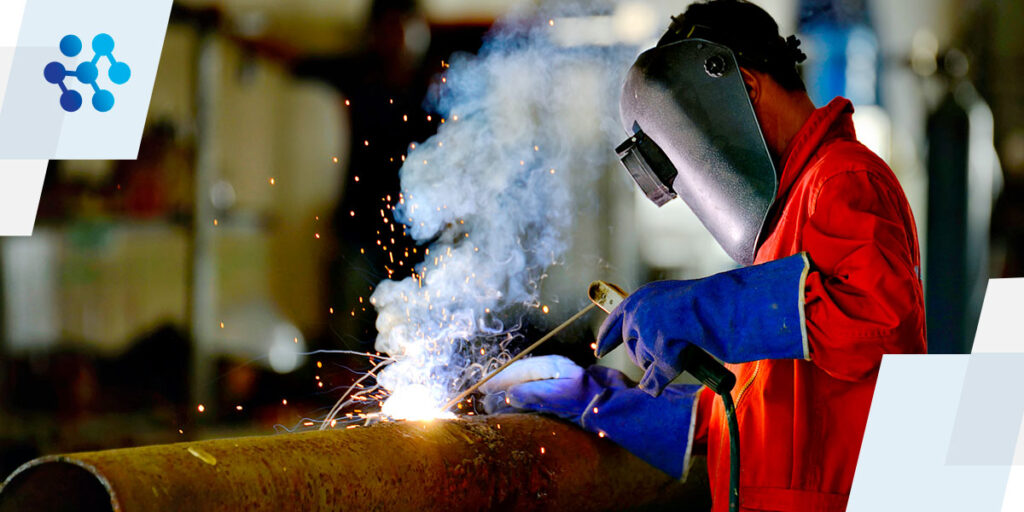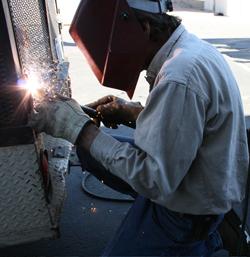Everything about Welding: Trick Insights Into Techniques and Best Practices for Success
Welding includes a variety of techniques, each fit for specific products and applications. Comprehending these techniques, such as GMAW, SMAW, and TIG, is necessary for accomplishing ideal outcomes. In addition, the best devices and safety and security techniques can not be neglected. As prep work and repairing play vital roles in the welding procedure, grasping these elements can greatly enhance the high quality of the end product. What are the essential elements that ensure an effective weld?
Understanding Different Welding Techniques
Welding methods encompass a variety of techniques, each matched to details applications and materials. Amongst one of the most typical strategies are Gas Metal Arc Welding (GMAW), Shielded Metal Arc Welding (SMAW), and Tungsten Inert Gas Welding (TIG) GMAW, also understood as MIG welding, is preferred for its speed and versatility, making it suitable for slim products. SMAW, or stick welding, is preferred for its simplicity and efficiency in outside atmospheres, particularly with thicker metals. TIG welding uses precision and control, making it suitable for detailed work and non-ferrous steels (Montana Mobile Welding and Repair Belgrade Welding). Each method has its distinct benefits and factors to consider, allowing welders to pick the very best method based on the project's demands, material type, and wanted outcomes. Recognizing these methods is important for effective welding
Necessary Welding Tools and Tools
While various welding methods need particular abilities, the appropriate tools and devices are similarly crucial for attaining high quality outcomes. Important welding tools includes welding machines, which differ relying on the method-- such as MIG, TIG, or stick welding. Safety gear, including headgears, aprons, and handwear covers, guarantees safety and comfort throughout the procedure. In enhancement, components and clamps assist secure products in location, ensuring precision in welds. Consumables like welding rods, cord, and securing gas are likewise vital parts that affect the quality of the weld. Devices such as cutters and grinders assist in surface area prep work and post-weld ending up, adding to a specialist result. Purchasing premium devices eventually boosts the efficiency and efficiency of welding jobs.
Safety And Security Practices in Welding
Appropriate security methods are necessary in the welding industry to shield workers from possible risks. Welders should wear suitable personal safety equipment (PPE), consisting of headgears with appropriate shading, gloves, and flame-resistant garments. Ample air flow is vital to minimize exposure to damaging fumes and gases created throughout the welding procedure. Furthermore, employees need to be learnt the right handling of welding equipment to stop accidents. Fire precaution, such as keeping flammable products far from the welding area and having fire extinguishers readily offered, are needed. Routine examinations of tools and work areas can aid determine possible threats before they result in crashes. By sticking to these security techniques, welders can produce a more secure working atmosphere and decrease risks related to their trade.
Preparing Materials for Welding
Preparing products for welding is a vital action that substantially influences the top quality and stability of the end product (Montana Mobile Welding and Repair Belgrade Fabrication). Proper prep work entails cleaning up the surface areas to get rid of impurities such as rust, oil, and dust, which can jeopardize the weld. Strategies such as grinding, sanding, or using solvents are typically employed to achieve a clean surface. In addition, making sure that the materials fit with each other comfortably is crucial; gaps can lead to weak welds. It's additionally important to take into account the alignment and positioning of the elements, as this will certainly affect the simplicity of welding and the final result. Selecting the ideal filler material and ensuring compatibility with the base metals is important for attaining solid, resilient welds.
Tips for Getting High-Quality Welds
Achieving top notch welds requires interest to detail and adherence to best methods throughout the welding procedure. Correct joint prep work is important, ensuring surfaces are clean and free from pollutants. Choosing the suitable filler product and welding method based upon the base metals is essential for perfect bonding. Maintaining regular travel rate and angle while welding can stop problems and promote harmony. Additionally, controlling warm input is crucial; extreme heat can cause warping and weakened joints. If necessary, frequently examining the welds during the procedure permits for immediate adjustments. Ultimately, using ideal post-weld therapies, such as cleaning and stress alleviation, can boost the toughness and stability of the weld, inevitably making sure an effective outcome.
Troubleshooting Common Welding Issues
Welding usually presents obstacles that can influence the top quality and stability of the final product. Common issues such as porosity, inconsistent weld grains, and getting too hot can occur, each requiring particular troubleshooting strategies. useful reference Recognizing these troubles is necessary for welders to improve their abilities and achieve excellent outcomes.
Porosity Issues Described
Porosity can typically be forgotten, it stays a critical problem in welding that can endanger the integrity of a completed product. Porosity refers to the presence of small gas pockets within the weld bead, which can lead and weaken the joint to early failing. This issue typically arises from impurities, moisture, or improper securing gas protection throughout the welding process. To alleviate porosity, welders must validate that the base materials are clean and completely dry, make use of proper protecting gases, and preserve constant welding specifications. On a regular basis evaluating the equipment and environment can additionally aid recognize prospective concerns prior to they show up in the weld. Dealing with porosity effectively is essential for attaining strong, long lasting welds that satisfy quality criteria.

Irregular Weld Beads
Irregular weld grains can greatly affect the quality and stamina of a completed item. Various factors add to this issue, consisting of incorrect traveling rate, incorrect amperage settings, and irregular electrode angles. When the welder relocates also quickly, a grain may appear slim and lack infiltration, while moving also slowly can create too much accumulation. Additionally, making use of the incorrect amperage can result in either damaging or excessive spatter, both of which concession weld stability. The welder's technique, such as irregular lantern movement, can also result in irregular bead appearance. To alleviate these problems, welders must focus on keeping steady, regulated motions and guaranteeing proper equipment setups to accomplish harmony in their welds. Uniformity is vital to attaining trusted and solid welds.
Overheating and Warping Issues
Extreme warm during the welding process can result in substantial overheating and deforming issues, affecting the architectural stability of the work surface. These problems frequently show read up as distortion, which can endanger positioning and fit-up, making more assembly testing. Elements adding to overheating include the choice of welding specifications, such as voltage and travel rate, in addition to the sort of material being welded. To reduce these problems, welders need to maintain consistent traveling rate and appropriate heat input while checking the work surface temperature. Furthermore, pre-heating or post-weld warmth treatment can assist reduce stresses triggered by quick air conditioning - Welding. Routine examination and adherence to best practices are important in avoiding overheating and making certain the long life and reliability of welded frameworks
Frequently Asked Questions
What Are the Career Opportunities in the Welding Industry?
The welding market offers diverse career opportunities, consisting of positions as welders, instructors, engineers, and assessors. Experts can operate in production, building and construction, aerospace, and vehicle industries, taking advantage of strong need and competitive wages in different roles.
Just How Can I Enhance My Welding Speed Without Giving Up Top Quality?
To company website boost welding speed without compromising top quality, one ought to practice reliable methods, preserve devices, maximize settings, and boost hand-eye coordination. Routine training and looking for feedback can additionally considerably add to accomplishing much faster, premium welds.
What Certifications Are Offered for Welders?
Numerous accreditations exist for welders, consisting of those from the American Welding Culture (AWS), the National Center for Building Education And Learning and Research (NCCER), and different industry-specific companies. These qualifications enhance employability and demonstrate ability proficiency.
Just How Does Welding Affect the Qualities of Metals?
Welding affects the buildings of steels by altering their microstructure, which can result in modifications in strength, hardness, and ductility. Heat input and cooling rates during the process considerably influence these product characteristics.
Can I Weld Dissimilar Metals Together?
